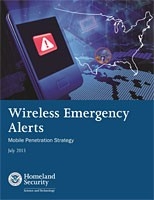Off Site
This report characterizes the factors that affect wireless emergency alert (WEA) coverage, identifies barriers to public access to WEA alerts, and suggests options for increasing mobile penetration (adoption) of WEA nationwide.
Please note: This report is not available on the RAND website but can be downloaded from the firstresponder.gov website.
Table of Contents
Chapter One
Introduction
Chapter Two
WEA Mobile Penetration Strategy
Chapter Three
Methodology
Chapter Four
Estimated Alert Originator Coverage and Barriers to Expanding Coverage
Chapter Five
Estimated CMSP Coverage
Chapter Six
WEA Compatibility of Mobile Devices
Chapter Seven
Estimated Population Adoption
Chapter Eight
User Acceptance and Public Awareness
Chapter Nine
Conclusions
Appendix A
List of Acronyms
Appendix B
WEA History and Motivation
Appendix C
Mobile Device Turnover Rate Model
Appendix D
Additional Detail on American Roamer Data and FCC Election Letter Matching
Appendix E
Additional Detail on Coverage Analysis
Research conducted by
The National Defense Research Institute, a division of the RAND Corporation, performed this analysis for the Department of Homeland Security Science and Technology Directorate.
This report is part of the RAND Corporation research report series. RAND reports present research findings and objective analysis that address the challenges facing the public and private sectors. All RAND reports undergo rigorous peer review to ensure high standards for research quality and objectivity.
The RAND Corporation is a nonprofit institution that helps improve policy and decisionmaking through research and analysis. RAND's publications do not necessarily reflect the opinions of its research clients and sponsors.


